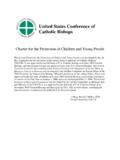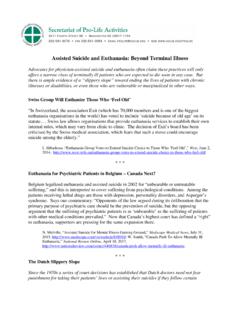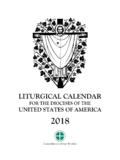Transcription of Summary of Roe v. Wade - United States …
1 Summary of roe v . wade and Other Key Abortion Cases roe v . wade 410 113 (1973) The central court decision that created current abortion law in the is roe v . wade . In this 1973 decision, the Supreme Court ruled that women had a constitutional right to abortion, and that this right was based on an implied right to personal privacy emanating from the Ninth and Fourteenth Amendments. In roe v . wade the Court said that a fetus is not a person but "potential life," and thus does not have constitutional rights of its own. The Court also set up a framework in which the woman's right to abortion and the state's right to protect potential life shift: during the first trimester of pregnancy, a woman's privacy right is strongest and the state may not regulate abortion for any reason; during the second trimester, the state may regulate abortion only to protect the health of the woman; during the third trimester, the state may regulate or prohibit abortion to promote its interest in the potential life of the fetus, except where abortion is necessary to preserve the woman's life or health.
2 Doe v. Bolton 410 179 (1973) roe v . wade was modified by another case decided the same day: Doe v. Bolton. In Doe v. Bolton the Court ruled that a woman's right to an abortion could not be limited by the state if abortion was sought for reasons of maternal health. The Court defined health as "all factors physical, emotional, psychological, familial, and the woman's age relevant to the well-being of the patient." This health exception expanded the right to abortion for any reason through all three trimesters of pregnancy. Planned Parenthood v. Danforth 428 52 (1976) The Court in Planned Parenthood v. Danforth invalidated broad portions of Missouri s abortion law including those which banned abortions by saline injection, required a married woman to obtain the consent of her husband prior to an abortion, and required consent of parents before an abortion could be performed on their minor daughter. The court approved in principle, but without explanation, the need for informed consent.
3 Maher v. Roe 432 464 (1979) The Court held that a State has authority to make a value judgment favoring childbirth over abortion and to implement that judgment by the allocation of public funds. It may, therefore, refuse to pay for an indigent s nontherapeutic abortion even though it subsidizes medical expenses related to pregnancy and childbirth under the State s Medicaid program. Colautti v. Franklin 439 379 (1979) The Court rejected a Pennsylvania statute that would have required doctors to protect the life of a fetus who may be viable both during and after an abortion. It ruled that only the doctor performing the abortion, and not a court or legislature, was competent to make a determination of viability. The statutory definitions were held to be vague. Harris v. McRae 448 297 (1980) The Court upheld the federal Hyde Amendment, which then restricted funding to only those abortions sought because the mother s life was endangered, stating that there is no constitutional right for a woman to have an abortion at public expense.
4 Since 1994, the Hyde Amendment has permitted funding for abortions where pregnancy was the result of rape or incest. v. Matheson 450 398 (1981) The Court upheld a statute requiring the doctor performing the abortion to notify one parent of a minor girl who is living at home with her parents, provided judicial bypass is available. City of Akron v. Akron Center for Reproductive Health 462 416 (1983) The Court invalidated informed consent requirements that included information on the medical risks of abortion, fetal development, alternatives to abortion, and a 24-hour waiting period. Also invalidated were provisions related to parental consent without judicial bypass, a provision requiring abortions to be performed only in hospitals after the first trimester, and one requiring fetal remains to be disposed of in a humane and sanitary manner. Thornburgh v. American College of Obstetricians and Gynecologists 476 747 (1986) The Court invalidated a Pennsylvania statute which required, inter alia, informed consent on fetal development, abortion alternatives, and the medical risks of abortion, reporting of abortions, and requiring that the physician use the abortion method most likely to preserve the life of a viable child.
5 Webster v. Reproductive Health Services 492 490 (1989) The Court upheld a Missouri statute which denied state funding and state employee participation in performing, or counseling for, abortion, but declined to uphold a provision requiring doctors to test for fetal viability before aborting a fetus of 20 weeks gestation or older. In Webster, four justices urged the reconsideration of roe v . wade . Rust v. Sullivan 500 173 (1991) The Court upheld federal regulations prohibiting family planning clinics receiving Title X funding from counseling or referring clients for abortion. Planned Parenthood of Southeastern Pa. v. Casey 505 833 (1992) The Court held States could require parental consent for a minor s abortion (as long as judicial bypass is available), require a waiting period between seeking and obtaining an abortion, and require detailed informed consent including medical information about the abortion. The State could not require a signed statement from the woman that she had given notice to her husband, if any, prior to the procedure.
6 Casey abandoned the trimester framework, replacing it with pre- and post-viability tests for constitutionality. Roe was reaffirmed although liberty replaced privacy as the alleged constitutional interest on the basis of stare decisis ( let the decision stand ), to avoid the appearance that the Court was vulnerable to political pressure, and because people had organized their intimate relationships and made choices that define themselves .. in reliance on the availability of abortion in the event contraception should fail. Four justices dissented from Casey s reaffirmation of Roe. Hill v. Colorado 530 703 (2000) A Colorado statute was upheld prohibiting sidewalk counseling within 100 feet of a health care facility, including an abortion clinic, by making it illegal to approach within 8 feet of a person to counsel, educate, show a sign or pass out a leaflet. In a complete reversal of First Amendment case law, the statute was found constitutional by protecting listeners from unwanted communication, being content neutral, and having a reasonable restriction on time, place, and manner.
7 Stenberg v. Carhart 530 914 (2000) The Court ruled unconstitutional Nebraska s ban on partial-birth abortion. The Court cited two grounds for striking down Nebraska s statute (and, by implication more than two dozen other similar state statutes): the absence of an exception to the ban for the health of the mother and because the Court found the description of the partial-birth abortion procedure to be vague and potentially including other mid- and late-term abortion procedures.









